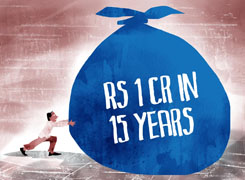Mushataq, 47, with ancestral home and Rs. 25,000 income - how to clear Rs. 13 lakh bank debt?
Ramalingam Kalirajan |10874 Answers |Ask -Follow
Mutual Funds, Financial Planning Expert - Answered on Jul 31, 2024
He has an MBA in finance from the University of Madras and is a certified financial planner.
He is the director and chief financial planner at Holistic Investment, a Chennai-based firm that offers financial planning and wealth management advice.... more

My name is mushataq ahmad 47 years of age having solitary daughter aged around 15 years .I have my own ancestral home I have monthly income of 25 thousand rupees and further having a liability of 13 lakh of banks how to get rid of that
Evaluating Your Financial Situation
Income Analysis: Your monthly income is Rs 25,000. We need to allocate this wisely.
Debt Concern: The bank liability of Rs 13 lakhs is significant. Reducing this should be a priority.
Future Planning: Planning for your daughter’s education and your retirement is essential.
Steps to Reduce Debt
Budgeting: Create a monthly budget. Track all your expenses and identify areas to cut costs.
Debt Repayment Plan: Allocate a fixed amount each month towards loan repayment. Consistency is key.
Prioritise High-Interest Loans: Focus on repaying loans with the highest interest first. This reduces the overall interest burden.
Boosting Income
Additional Income Sources: Look for additional income opportunities. Part-time jobs or freelancing can help.
Skills Upgrade: Consider learning new skills. This can lead to better job opportunities and higher income.
Investment Strategy
Emergency Fund: Maintain an emergency fund. This should cover 6 months of expenses for unforeseen circumstances.
Systematic Investment Plan (SIP): Start SIPs in actively managed equity mutual funds. These offer potential for higher returns.
Public Provident Fund (PPF): Invest in PPF for long-term savings. It offers tax benefits and guaranteed returns.
Avoiding Index and Direct Funds
Actively Managed Funds: These funds have professional managers. They make strategic decisions to maximise returns.
Regular Funds Through CFP: Investing through a Certified Financial Planner ensures expert advice and better fund selection.
Education Planning for Daughter
Child Education Plan: Start a dedicated fund for your daughter’s education. Regular contributions will grow over time.
Scholarship Opportunities: Explore scholarship options for your daughter. This can reduce future education expenses.
Retirement Planning
Retirement Fund: Start a retirement fund with long-term growth investments. SIPs in equity mutual funds can be effective.
Review Existing Policies: If you have LIC or ULIP policies, evaluate their performance. Consider surrendering underperforming policies and reinvesting in mutual funds.
Managing Expenses
Frugal Living: Adopt a frugal lifestyle. Prioritise needs over wants.
Avoid Unnecessary Debt: Avoid taking on new loans. Focus on clearing existing liabilities first.
Closing Remarks
Reducing debt, increasing income, and strategic investments will improve your financial health. Regular reviews and adjustments are key to staying on track.
Best Regards,
K. Ramalingam, MBA, CFP,
Chief Financial Planner,
www.holisticinvestment.in
You may like to see similar questions and answers below
Ramalingam Kalirajan |10874 Answers |Ask -Follow
Mutual Funds, Financial Planning Expert - Answered on Aug 22, 2024
Ramalingam Kalirajan |10874 Answers |Ask -Follow
Mutual Funds, Financial Planning Expert - Answered on Jun 16, 2024
Ramalingam Kalirajan |10874 Answers |Ask -Follow
Mutual Funds, Financial Planning Expert - Answered on Jul 22, 2024
Ramalingam Kalirajan |10874 Answers |Ask -Follow
Mutual Funds, Financial Planning Expert - Answered on Jul 25, 2025
Samraat Jadhav |2499 Answers |Ask -Follow
Stock Market Expert - Answered on Jul 11, 2025
Mayank Chandel |2569 Answers |Ask -Follow
IIT-JEE, NEET-UG, SAT, CLAT, CA, CS Exam Expert - Answered on Dec 08, 2025
Mayank Chandel |2569 Answers |Ask -Follow
IIT-JEE, NEET-UG, SAT, CLAT, CA, CS Exam Expert - Answered on Dec 08, 2025

Mayank Chandel |2569 Answers |Ask -Follow
IIT-JEE, NEET-UG, SAT, CLAT, CA, CS Exam Expert - Answered on Dec 08, 2025
Mayank Chandel |2569 Answers |Ask -Follow
IIT-JEE, NEET-UG, SAT, CLAT, CA, CS Exam Expert - Answered on Dec 08, 2025
Mayank Chandel |2569 Answers |Ask -Follow
IIT-JEE, NEET-UG, SAT, CLAT, CA, CS Exam Expert - Answered on Dec 08, 2025
Anu Krishna |1746 Answers |Ask -Follow
Relationships Expert, Mind Coach - Answered on Dec 08, 2025
Ramalingam Kalirajan |10874 Answers |Ask -Follow
Mutual Funds, Financial Planning Expert - Answered on Dec 08, 2025
Samraat Jadhav |2499 Answers |Ask -Follow
Stock Market Expert - Answered on Dec 08, 2025
Ramalingam Kalirajan |10874 Answers |Ask -Follow
Mutual Funds, Financial Planning Expert - Answered on Dec 08, 2025
Radheshyam Zanwar |6737 Answers |Ask -Follow
MHT-CET, IIT-JEE, NEET-UG Expert - Answered on Dec 08, 2025






















